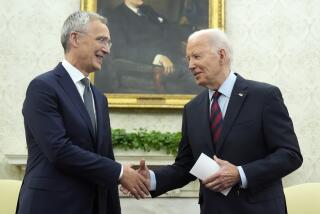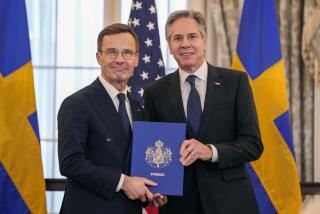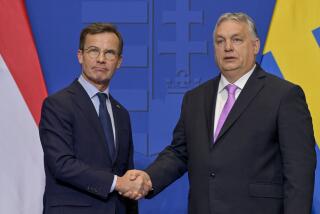Swedes Face Cold Reality of Trying to Remain Neutral--Within Budget
- Share via
STOCKHOLM — Swedish military officers have little to be cheery about these days, beyond their tests showing that hangar-size igloos can withstand direct hits from artillery.
Storage igloos, made of something that comes from the sky for free, are just what Sweden’s military needs. Parliament is slashing defense spending while insisting on a self-defense capability that the military says it can no longer afford.
The dispute is tied to a fundamental question that Sweden has been wrestling with since the end of the Cold War: To remain neutral or not?
Even though there are no competing alliances to be neutral between anymore, the question is tough. Many Swedes believe neutrality has kept the country out of wars for 183 years. An official shift in defense policy would be a political minefield.
Nevertheless, Sweden has joined the European Union, which is committed to developing a common defense policy and is working on a joint military force. And Sweden is a member of NATO’s Partnership for Peace program and now has more than 800 soldiers under North Atlantic Treaty Organization command in Bosnia-Herzegovina.
For this Nordic country, those steps broke a period of military isolation stretching back to the final years of the Napoleonic Wars.
Still, the Social Democratic government affirmed in December that it will not join NATO. At the same time, the government, which is struggling to save a debt-ridden welfare state, decided to cut the current $6.2-billion defense budget by 10% over the next five years.
The plan brought an outcry from opposition politicians and military leaders, who say the cutbacks will rob Sweden’s ability to stand on its own. Without a well-financed military, Sweden will have to turn to NATO to safeguard its national security, they say.
Defense Minister Thage Peterson, who has led the move toward reduced defense budgets, disputes that. He insists there are no threats to Sweden after the demise of the Soviet Union.
“The military must wake up to the fact that times have changed,” he said.
Gen. Owe Wiktorin, the military chief of staff, agrees there is no immediate threat to Sweden, but he argues that could change quickly if Russia shifts its political course away from accommodation with the West.
Traditionally, Sweden has maintained a strong defense to give credibility to its neutrality, spending more of its economic output on the military than many European nations.
A nation of 8.7 million people, it can mobilize half a million soldiers, sailors and airmen--nearly all of them reservists. Full-time military service of seven to 12 months is mandatory for men.
The Swedes have built up a big arms industry to avoid entanglement with any alliance. Their factories produce sophisticated weapons such as the JAS 39 Gripen jet fighter, submarines, warships, artillery, missiles and tanks.
The government’s critics say those cornerstones of neutrality are being hollowed out for lack of money.
Wiktorin, who has disagreed publicly with the defense minister, says the cuts mean the military will be unable to defend Sweden against a major attack. The army will shrink from 16 brigades to 12; the navy will drop from 42 warships to 27; the air force will drop from 16 squadrons to 12.
The spending cuts are also a threat to the arms industry, which includes major companies such as the Saab aerospace group, missile-maker Bofors and submarine-maker Kockums. They have been heavily dependent on domestic orders. The government is openly encouraging arms exports and telling manufacturers to seek partners abroad to survive.
Igloos are among the least-threatened projects. The military is considering them for ammunition depots, hangars and other purposes. They can absorb explosions without collapsing and are difficult to detect--although their potential melts when it comes to summer and exports.
Many analysts say the cuts in defense spending will force Sweden to eventually join an alliance regardless of the official line.
“We are witnessing a creeping integration” into NATO by early next century, said Sune Persson, a Swedish security expert.
But the sacred cow--the notion that Sweden has stayed out of European conflicts--remains a formidable block in the public debate, although historians and journalists have started chipping away at it.
Their reports have revealed that Sweden did not remain aloof in World War II. Swedish security police gave the Germans access to names of Danish resistance fighters, while the government allowed Britain to help direct bombings of Berlin from southern Sweden.
It was a different story during the Cold War. Sweden cooperated secretly with Western nations, such as working with their intelligence services and building Swedish airstrips to NATO standards.
And behind the rhetoric of neutrality, the Swedish military always assumed the enemy would be the Soviet Union and the strategy would be to hold out until help arrived--from the West.
(BEGIN TEXT OF INFOBOX / INFOGRAPHIC)
Sweden’s Military Strength
Some facts on Sweden’s military:
* Defense budget: 40 billion kronor ($6.2 billion), decreasing 10% over next five years. Defense share of government budget: 10.9% in 1975, 8.4% in 1985, 6.9% in 1995.
* Manpower: 450,000 in army, 70,000 in navy, 70,000 in air force. Most are reservists.
* Army: 16 brigades--three mechanized, two tank, six infantry, five arctic. Cutting to 12 brigades. Also has 100 unattached tank, infantry, commando, artillery and air defense battalions.
* Navy: 30 surface ships, 12 submarines. Cutting to 20 ships, seven submarines.
* Air force: 400 warplanes in 16 squadrons. Cutting to 216 aircraft in 12 squadrons.
Source: Associated Press
More to Read
Sign up for Essential California
The most important California stories and recommendations in your inbox every morning.
You may occasionally receive promotional content from the Los Angeles Times.










